November 9, 2013
[singlepic id=245 w=320 h=240 float=left]
On the 30th of October, the perfectly serene pool in Claude Monet’s garden offers a mirror view of the world around.
Blue sky and turning trees create a bold contrast between the still floating water lily pads.
(Click on the picture to enlarge).
Posted in Giverny, Water-Garden 1 Comment »
September 18, 2013
[singlepic id=244 w=320 h=240 float=right]
An unusual light on Monet’s water lily pond, while big dark clouds are loaming ahead… Just time enough to walk around the pound, and the drops will start to fall on the surface of the pool in hundreds of little circles.
Posted in Giverny, Water-Garden 2 Comments »
October 27, 2012
[singlepic id=230 w=320 h=240 float=left]Claude Monet planted a beautiful bamboo grove in his water garden at Giverny.
Bamboos are ever green. This picture was taken on the 1st of November, the very last day of the season, and even on such a late date bamboos were as pretty as ever.
Bamboos are not native to France. The golden bamboos that Monet chose look very tall and exotic in Normandy.
Monet liked growing giant plants and Japanese plants, and bamboos were both at the same time.
As a clever gardener, the painter chose the best location for them: on an island of his water garden, where they would get enough water, and where the invasive roots would be contained by the stream.
He never painted them, but certainly liked the contrast their shade produces with the pond, that is open and full of light.
After Monet passed away, the garden was left without much tending for long years. But the bamboos have survived, because they regenerate spontaneously, making new shoots every year.
During the decades when Monet’s house was left uninhabited, the garden became the playground of the children of Giverny. One of their favorite games was playing Tarzan in Monet’s bamboo grove. For them, it looked like a rain forest.
Posted in Flower, Water-Garden No Comments »
July 26, 2012
[singlepic id=225 w=320 h=240 float=left]Here are the moor hens living on Claude Monet’s pond at Giverny.
Every year, they nest on the island in the middle of the pond, or in the shrubs around. After a few weeks, they appear on the water with their adorable little chicks, five of them generally.
They are so sweet, light enough to walk on the lily pads. Both parents take care of them. But it won’t help.
Because we are human beings with a memory, we know what’s going to happen next: the ducklings will end in the belly of the pike living in the pond. This is the cruel story that repeats every year.
But because they are moor hens, and have not much space for brains in their head, they forget every year and keep nesting on the same location.
This afternoon two of the smalls only were left.
Posted in About Nature, Water-Garden No Comments »
May 20, 2012
[singlepic id=215 w=320 h=240 float=right]This is Monet’s pond at Giverny seen from the Japanese Bridge in May, when the wisterias are in bloom.
The water lily pads float like islands on the surface. No flowers yet.
Short before closing time, visitors are few. The late afternoon sunshine enlightens the trees on the eastern side of the pool. Silence falls on the garden. The scent of the flowers is in the air.
Posted in Giverny, Water-Garden No Comments »
January 2, 2012
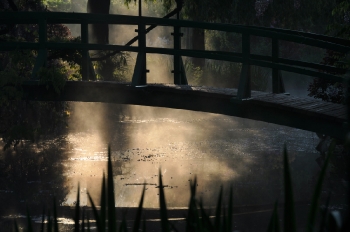 Best wishes
Best wishes
from Giverny
for a splendid
year 2012
full of light
and beauty!
Posted in Giverny, Water-Garden No Comments »
November 17, 2011
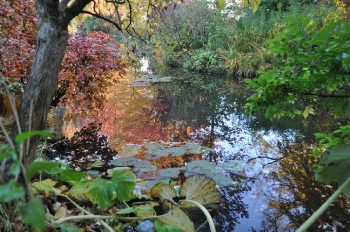 This is how Monet’s pond looks on November 1st, minutes before closing for the winter.
This is how Monet’s pond looks on November 1st, minutes before closing for the winter.
Soft or spectacular, according to sunshine.
Posted in Giverny, Water-Garden No Comments »
October 17, 2011
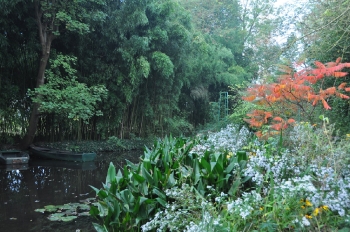 The misty days of October are back! On Monet’s pond at Giverny, they create a soft atmosphere enhancing the different textures of the foliages. Among all these greens, the sumac of Virginia flames. Asters fill in the flower beds in big bouquets. The boat awaits the gardener. He will soon arrive to maintain the pond.
The misty days of October are back! On Monet’s pond at Giverny, they create a soft atmosphere enhancing the different textures of the foliages. Among all these greens, the sumac of Virginia flames. Asters fill in the flower beds in big bouquets. The boat awaits the gardener. He will soon arrive to maintain the pond.
Posted in Giverny, Water-Garden 1 Comment »
October 11, 2011
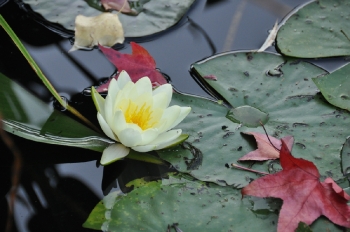 Autumn leaves fall on Claude Monet’s pond at Giverny, creating new beauties, new color harmonies.
Autumn leaves fall on Claude Monet’s pond at Giverny, creating new beauties, new color harmonies.
Posted in Water-Garden 1 Comment »
July 3, 2011
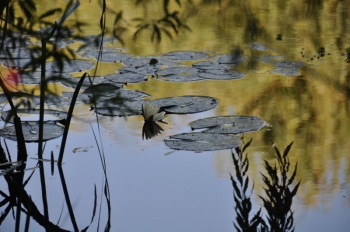 Water lilies are sensitive to cold. When the night is overcast and mild, they are all open in the morning. But if the night is clear, they close and need several hours of sunshine to open again.
Water lilies are sensitive to cold. When the night is overcast and mild, they are all open in the morning. But if the night is clear, they close and need several hours of sunshine to open again.
They like a warm water not only to open, but also to bloom. On Monet’s pond, water lilies are gorgeous during heat waves, they become scarce during rainy and cool periods.
This is true for a big pond like Giverny. For gardeners who would like to grow water lilies in a wash basin, it is wise to look for a partly shaded spot. In direct sunshine, the water of a small container becomes very warm. If some like it hot, it is not the case of water lilies.
Posted in Flower, Giverny, Water-Garden No Comments »
May 30, 2011
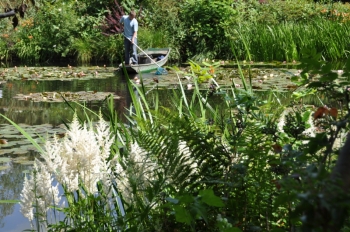 Monet’s Garden at Giverny is not a low maintainance garden. In the 19th Century, having gardeners and helpers was not as expensive as today. The wealthy painter could afford up to six full time gardeners to manucure his 5 acre garden.
Monet’s Garden at Giverny is not a low maintainance garden. In the 19th Century, having gardeners and helpers was not as expensive as today. The wealthy painter could afford up to six full time gardeners to manucure his 5 acre garden.
One of the heavy task of his times that is still a daily core today was the skimming of the pond to take out all the dried leaves or petals floating on the surface.
The pond being surrounded by trees and flowers, it is the only way to keep the water clear.
The job takes two hours and must be done almost every day.
Posted in Water-Garden 2 Comments »
November 29, 2010
[singlepic=167,350,350,,left]The beauty of late season at Giverny relies on the reflections on Monet’s pond.
The surrounding trees turn red, orange, yellow and dip their image into the water.
Their warm colors split in dots of changing shapes form a stunning contrast with the cold blue and perfectly defined leaves of the remaining water lilies.
This picture was taken one month ago. Now the leaves have been blown away, and Fondation Claude Monet is closed until next 1st April.
Posted in Giverny, Water-Garden No Comments »
November 8, 2010
[singlepic=163,350,350,,left]In his water garden at Giverny, Claude Monet planted tall trees like weeping willows, ash trees, chestnut trees, poplars, copper beeches…
They were underplanted by shrubs that offered their interesting foliages, flowers, berries, and scents: roses, tree peonies, azaleas, rhododendrons, viburnums, Japanese maples, ferns…
These shrubs were underplanted by flowers, for example flag irises, to provide a touch of vibrant color.
Thus, Monet created a little world that resembled a clearance in the woods.
He liked to feel blended with nature. Staring at the reflections of the sky into the pond, he could loose any notion of himself and merge into the waterscape.
Posted in Water-Garden No Comments »
May 1, 2010
[singlepic=149,350,350,,right]Early in the morning, long before the first visitor arrives in Monet’s garden at Giverny, rays of orange sunshine stroke the Japanese bridge of the water garden, while a light mist raises from the pond.
Monet, who was an early bird, loved to get up before sunrise, in order not to miss a second of the dramatic show of light and water.
Posted in Claude Monet, Giverny, Water-Garden No Comments »
January 14, 2010
[singlepic=141,350,350,,left]It was a dream come true for me to enter Monet’s garden at sunset to take pictures of the dusk.
Cold Winter days finish in a symphony of very tender colors, soft pinks and blues, whereas milder days generally offer dramatic sunsets with flaming reds on low clouds.
As it was last week, it was just incredible to be there, in the absolutely empty garden, walking around the frozen water lily pond waiting for the sky to change.
During the Winter parenthesis, when it is closed for five months, Giverny stops being iconic. Monet’s pool is no more the motiv for world wide known canvases. It becomes a patch of nature again, a very small place indeed lost in the frozen landscape. The realm of wild life.
Posted in Water-Garden No Comments »





